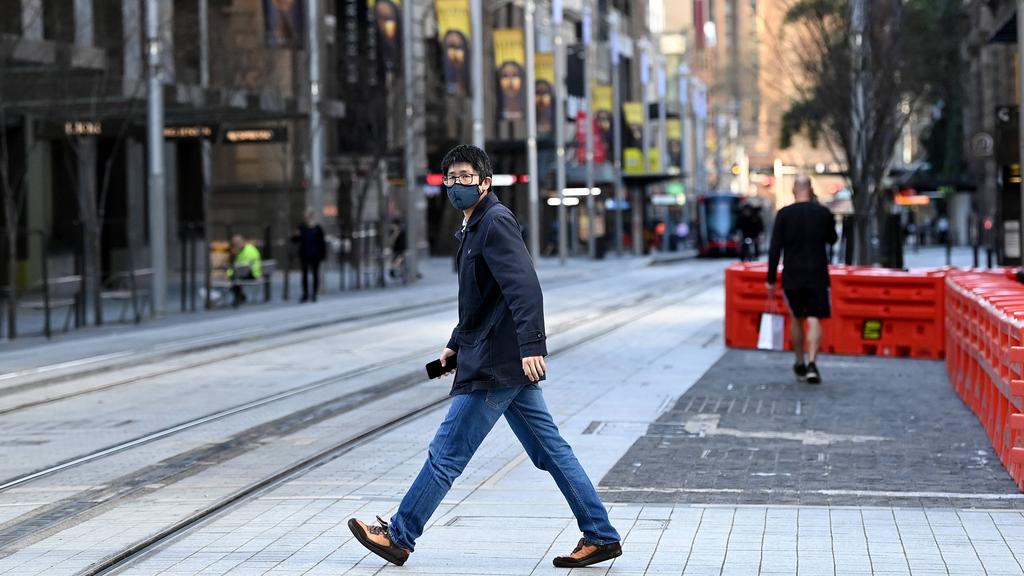Cities deserted but office tower investment flows sparking up

The Property Council of Australia’s latest office occupancy survey found that the occupancy level of Sydney’s CBD is sitting at just 4 per cent of pre-Covid-19 levels. Picture: NCA NewsWire/Bianca De Marchi
Harsh lockdowns have sent the occupancy rates of offices in Sydney and Melbourne plummeting back below 10 per cent as the cities combat the Covid-19 delta variant.
The tough situation is a pointer to the difficulties that major corporations will have in luring staff back to their desks as the lockdowns drag on.
Landlords argue that major companies have a healthy appetite for space, even though their staff are not in the office and they consider switching to hybrid models.
But the difficult situation for occupancy has been almost reversed in investment markets, as buyers are looking well past the initial crisis.
Billions of dollars worth of office towers are in play in one of the largest selling seasons for years, partly as institutions upgrade to owning buildings that will come through the crisis.
Major players Dexus and Investa each have billion dollar-plus portfolios in the market and more large assets are hitting the blocks, with private developer Alfasi joining the rush by selling a half stake in its new $250m tower in the Melbourne suburb of Cremorne.
They finding buyers, with the likes of Singapore-linked including CapitaLand and the AIMS Financial Group running on large offices in Sydney that have been offered this year.
Fringe city assets are also running hot, with the Melbourne’s Deague family selling another city fringe asset for $205m this week to Centuria Capital. That company also picked up at office building in Adelaide for $63m in a sign it is casting a wide net for long leased assets.
Buildings carrying long leases are coming into their own in the crisis as investors bet that big companies will still need space once the crisis is over.
But for now cities lie empty, prompting calls for short-term help.
The Property Council of Australia’s latest office occupancy survey found that the occupancy level of Sydney’s CBD is sitting at just 4 per cent of pre-Covid-19 levels, as authorities battle to contain the pandemic.

Property Council of Australia CEO Ken Morrison. Picture: AAP
Melbourne’s CBD is experiencing similar problems, recording only 7 per cent of pre-Covid-19 occupancy in August. Canberra’s lockdown resulted in the most dramatic decline in occupancy across the country last month, with the nation’s capital falling from 73 per cent to 8 per cent of pre-Covid-19 levels.
Cities emerging from recent lockdowns recorded strong recoveries in the number of workers returning to their offices. Brisbane and Adelaide CBDs had 60 per cent and 65 per cent of pre-Covid occupancy respectively.
Property Council chief executive Ken Morrison said there was a challenge ahead in restoring cities. “Our CBDs support millions of jobs and generate hundreds of billions of dollars in economic activity,” Mr Morrison said.
“We know that lockdowns are having a big impact on our CBDs, but it is encouraging to see that once lockdowns are lifted workers are returning at faster rates than we recorded in 2020.”
He called for a “concerted effort” form policymakers to accelerate CBD recovery as we move through the stages of the national plan.
The survey found a significant 26 per cent variance in the number of workers attending their offices between weekly peak days and low days in unrestricted CBDs.
“The recent delta outbreaks have not impacted all cities equally and have created two distinct challenges across our city centres,” Mr Morrison said. “For the capitals that have been less affected, we need to find a way of enticing workers to increase their number of days in the office.”
“Once we’ve overcome the immediate threats to public health, it is critical that building owners and employers work together with all levels of government to get our CBDs firing on all cylinders once again,” Mr Morrison said.
Most landlords and managers said they did not expect to see a material increase in CBD office occupancy levels within the next three months.







